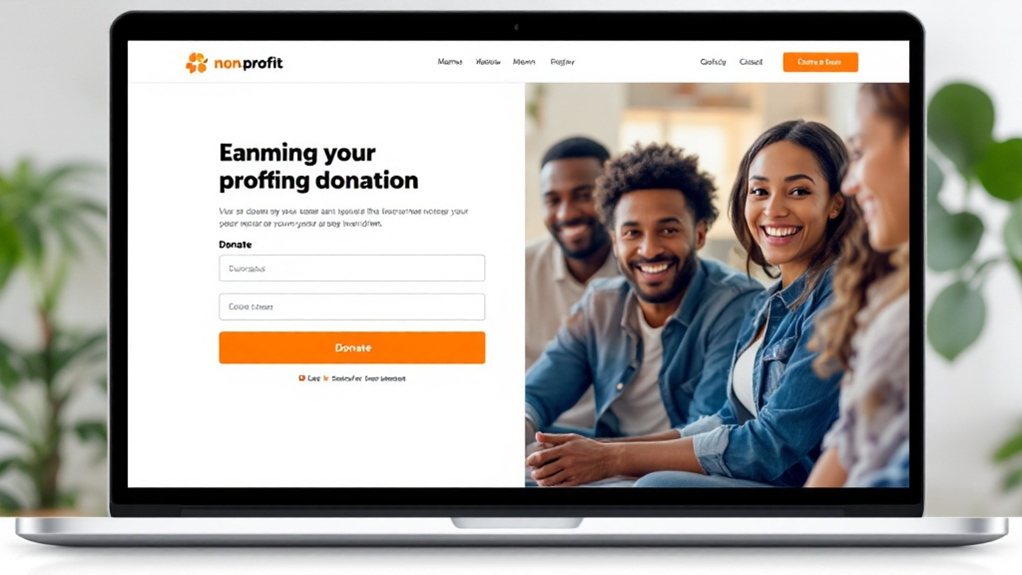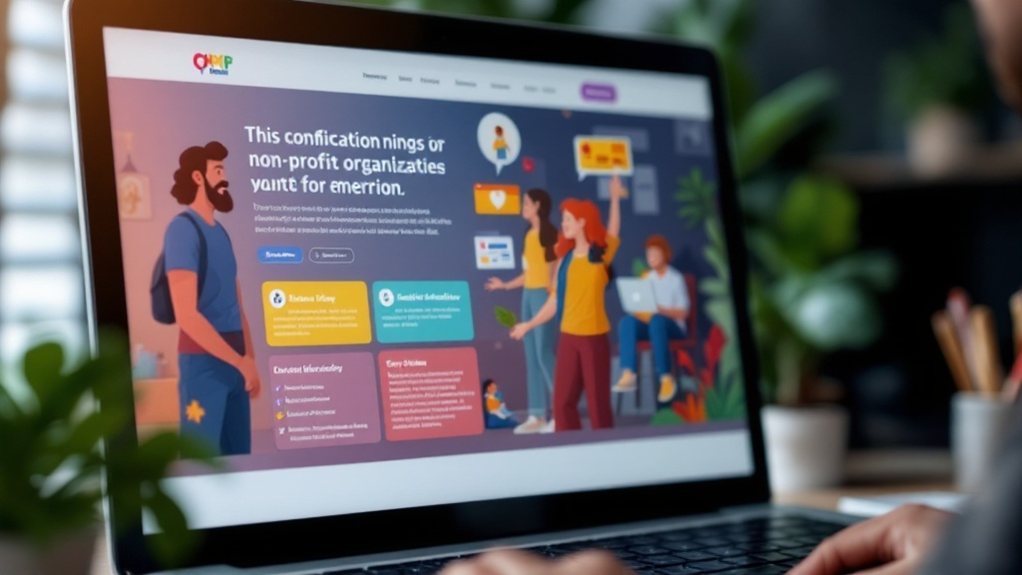Designing an effective website for a non-profit requires understanding its mission, audience, and initiatives. You'll want to prioritize accessibility, optimize for mobile, craft a compelling visual identity, and streamline the donation process. Additionally, you'll need to leverage effective content management, secure infrastructure, and user behavior analysis to continuously improve the website. Keep reading to dive deeper into these key considerations for non-profit website design.
Key Takeaways
- Align the website with the non-profit's mission, goals, and target audiences to effectively advance the organization's objectives.
- Prioritize accessibility and inclusivity by providing multi-lingual content, captioned media, and intuitive navigation to engage diverse stakeholders.
- Optimize the website for mobile-friendly design with responsive layouts, streamlined navigation, and fast-loading media to deliver a seamless user experience.
- Develop a cohesive visual identity that captivates the audience, reinforces the non-profit's values, and creates a memorable brand impression.
- Streamline the donation process with clear calls-to-action, secure payment options, and recurring donation features to encourage long-term financial support.
Understanding the Non-Profit's Mission and Objectives

When designing a website for a non-profit organization, it's crucial to first understand their mission and objectives. What are they trying to achieve? Who are their target audiences? What are their key initiatives and programs? Knowing the answers to these questions will inform the website's content, design, and functionality. You'll be able to create a site that effectively communicates the non-profit's purpose, highlights their work, and encourages engagement from visitors. Additionally, aligning the website with the organization's mission will ensure it serves as a valuable tool in advancing their goals. This foundational understanding is the first step towards building a website that truly resonates with the non-profit and its stakeholders.
Prioritizing Accessibility and Inclusivity
Prioritizing accessibility and inclusivity is paramount when designing a website for a non-profit organization. Ensuring your website is accessible to individuals with disabilities, such as providing alt text for images and closed captions for videos, demonstrates your commitment to inclusion. Additionally, consider translating content into multiple languages to reach a broader audience. Optimize the user experience by using clear, jargon-free language and intuitive navigation. Solicit feedback from diverse stakeholders to identify and address potential barriers. By prioritizing accessibility and inclusivity, you'll create a website that truly reflects your non-profit's values and welcomes all visitors.
Optimizing for Mobile-Friendly Design

Ensuring your non-profit's website is mobile-friendly can't be overstated. With more users accessing the web on their smartphones, you must design your site to deliver an optimal experience on smaller screens. Prioritize a responsive layout that adapts seamlessly to various devices. Streamline navigation, ensure readability, and optimize images and media for faster loading times. Leverage mobile-specific features like tap-to-call or location-based services to enhance user engagement. Regularly test your site's performance on different devices and browsers, making adjustments as needed. Investing in a mobile-friendly design will expand your reach, boost engagement, and better serve your non-profit's mission.
Crafting a Compelling Visual Identity
How vital is a compelling visual identity for your non-profit's website? It's the foundation that shapes users' first impressions and conveys your organization's mission and values. A strong visual identity reinforces your brand, making it memorable and recognizable. Craft a cohesive color palette, typography, and imagery that aligns with your cause. Use high-quality, emotive visuals that engage visitors and evoke the right emotions. Consistent branding across your website, social media, and other touchpoints builds trust and credibility. Invest time in developing a visually stunning, user-friendly design that captivates and inspires your audience. Your visual identity is a powerful tool to differentiate your non-profit and rally support for your important work.
Streamlining the Donation Process

Though a visually captivating website is essential, ensuring a streamlined donation process is equally crucial for non-profits. Donors should be able to locate the donation page with ease and complete the transaction swiftly. Incorporate clear calls-to-action, prominent donation buttons, and a mobile-friendly layout. Minimize form fields and provide secure payment options. Offer recurring donation options to encourage long-term support. Follow up with donors through acknowledgments and impact reports to foster a sense of partnership. Regularly analyze donation data to identify friction points and optimize the process. A smooth, user-centric donation experience can significantly boost conversions and sustain your organization's vital work.
Highlighting Volunteer Opportunities
Prominently showcase your organization's volunteer opportunities on the website to attract engaged supporters. Make it effortless for visitors to find ways to get involved, whether through regular commitments or one-time events. Provide detailed descriptions of each role, outlining the responsibilities, time commitment, and impact. Showcase volunteer stories and testimonials to inspire others to join. Streamline the sign-up process, allowing interested individuals to express their interest with just a few clicks. Highlight the benefits of volunteering, emphasizing the personal growth, sense of purpose, and community connection it can provide. Showcase upcoming volunteer activities and events, enabling visitors to easily find opportunities that align with their schedule and interests.
Incorporating Educational Resources

Incorporating educational resources on your non-profit's website can educate and inspire visitors, ultimately driving them to get involved. Provide informative content about your organization's mission, programs, and impact. Share blog posts, videos, and infographics that showcase your work. Offer downloadable guides, toolkits, or webinars to help supporters understand complex issues. Highlight success stories and testimonials to demonstrate your non-profit's effectiveness. Curate a resource library with relevant external links and recommended reading. Ensure all content is accessible, engaging, and aligned with your branding. Educational resources empower your audience, cultivate trust, and encourage deeper connections with your cause.
Facilitating Community Engagement
Fostering community engagement is crucial for the success of your non-profit organization. Your website should provide avenues for visitors to connect, collaborate, and contribute. Incorporate interactive features like forums, discussion boards, and comment sections to facilitate discussions around your cause. Encourage supporters to share their stories, volunteer experiences, and ideas. Highlight user-generated content, such as testimonials and photographs, to showcase the impact of your organization. Leverage social media integration to amplify your reach and enable seamless sharing. Remember, an engaged community can generate valuable feedback, foster a sense of ownership, and drive sustainable growth for your non-profit.
Leveraging Effective Content Management

Effective content management is the backbone of a successful non-profit website. It allows you to easily update and organize your online presence, ensuring your message resonates with your audience. Leverage a content management system (CMS) that empowers your team to manage web pages, blog posts, and multimedia without technical expertise. Optimize your content for search engines, making it easier for potential donors and volunteers to find you. Regularly review and refresh your content to keep it relevant and engaging. Embrace the power of storytelling to showcase your impact and inspire action. With a well-managed website, you'll strengthen your online presence and deepen connections with your community.
Implementing Secure and Reliable Infrastructure
A secure and reliable infrastructure is paramount for your non-profit website. Protect your organization's sensitive data and ensure your site remains accessible to your audience. Implement robust security measures, such as SSL/TLS encryption and regular software updates. Utilize a content delivery network (CDN) to enhance site speed and availability. Invest in a reliable web hosting provider with redundant systems and comprehensive backup solutions. Regularly monitor your infrastructure for potential vulnerabilities and develop an incident response plan. By prioritizing security and reliability, you can build trust, safeguard your mission, and provide a seamless user experience for your non-profit's website visitors.
Analyzing User Behavior and Performance

Analyzing user behavior and performance is crucial for optimizing your non-profit's website. By tracking and understanding how users interact with your site, you can make data-driven decisions to enhance their experience and increase engagement. Leverage analytics tools to monitor metrics like bounce rate, time on page, and conversion rates. Identify areas where users struggle or drop off, then make targeted improvements. Additionally, conduct user testing to gather direct feedback and observe real-world usage. Combining quantitative and qualitative data will provide a well-rounded perspective on your website's performance. Remember, website optimization is an ongoing process; continuously analyze, refine, and iterate to ensure your non-profit's online presence effectively supports its mission.
Maintaining Ongoing Website Optimization
While website optimization is an ongoing process, it doesn't have to be a daunting one. Continuously monitor your website's performance, analyze user behavior, and make incremental improvements. Identify and fix technical issues, optimize content, and streamline the user experience. Leverage analytics tools to track key metrics and gain insights. Implement A/B testing to explore alternative designs and features. Engage your audience by responding to their feedback and adapting to their evolving needs. Collaborate with your team to prioritize and execute optimization strategies. Maintain a systematic approach, celebrate small wins, and stay agile. Remember, website optimization is a journey, not a destination, so embrace it as an opportunity to elevate your non-profit's online presence.

